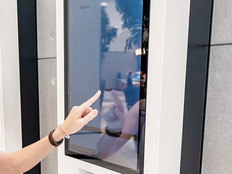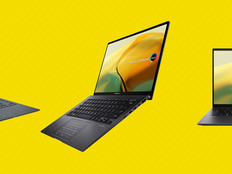Signs of the Times

The NavyArmy Federal Credit Union is treating customers with new eye candy as they walk through branch lobbies and stand in teller lines: stylish plasma screens providing news, information and the financial institution’s latest promotions.
On a series of digital displays, the credit union broadcast a presentation last fall that displayed holiday bank hours, current rates on savings accounts and certificates of deposit, and animated holiday greetings from Santa Claus. The displays show a mix of colorful slides, flashy graphics and video, and is a more effective marketing tool than the poster boards and single-color, text-based LED screens that the credit union previously used, says Shannon Srp, vice president of information systems.
“If you have static marketing, you lose your audience’s attention,” says Srp. “These plasma screens keep our marketing content fresh, and keep our customers looking at it and not just ignoring it,” says Srp, who purchased high-definition Samsung displays for the credit union’s 11 branch locations in the Corpus Christi, Texas, area.
Businesses are rapidly adopting digital signs as the technology becomes more affordable and offers a new platform to communicate and market to customers. Companies can change messaging on the fly and pinpoint their marketing strategies based on location or time. A mall retailer, for example, can use displays to target adults on weekdays and tweak the messages for teenagers on the weekend. And because they no longer have to print and install marketing and advertising posters, businesses enjoy cost and time savings, industry experts say.
“Digital signage is a powerful communications medium that gives companies the ability to highly target messages at points where people make purchases or wait,” says Lyle Bunn, a digital signage consultant in Brighton, Ontario.
Retail stores, restaurants and movie theaters are among the early adopters, but business offices also deploy the technology for both external and internal communications, Bunn says. A dentist’s office waiting room can have a digital sign that offers dental hygiene tips or suggests new services. Companies are also beginning to install displays in their office lobbies or cafeterias to broadcast company news or announcements to employees, he says.
Get the Word Out
The NavyArmy Federal Credit Union explored several systems, including its own in-house solution, before standardizing on commercial-grade Samsung displays with built-in computers running Windows XP Embedded. Srp installed one 40-inch screen at each branch last summer, either in the lobby or behind the teller windows. For the larger corporate office, he added another 52-inch screen. The displays gave the IT department the manageability and ease of use it needed, he says.
Samsung provided free Samsung MagicNet software that lets the IT staff create presentations, set a schedule for the content to be broadcast and deliver the material securely over the network. The displays have power management features, including sleep mode, and remote management features that let IT staff lock each display’s buttons so children can’t tamper with the settings. The IT staff can customize marketing campaigns for each of the credit union’s branch offices; for instance, broadcasting a special promotion for a new service area, Srp says.
So far, the technology works perfectly, and Srp plans to purchase an additional display for each branch. The credit union uses mostly PowerPoint slides, but plans to take advantage of Flash and video. Srp may also split the screen into several quadrants to run different content simultaneously, including weather forecasts.
“We started with baby steps, but now we’re getting to the point where we will fully utilize the capabilities,” he says.
Visual Appeal
For Landmark Theatres, which owns 55 movie theaters in 20 metropolitan areas, taking advantage of digital signs is a no-brainer, considering the visual medium the company is in.
The company’s three-story flagship theater in West Los Angeles features about 50 digital signs, showing movie times at the box office, menus at the concession stand and movie posters in the lobby. Displays at the theater’s wine bar show a countdown clock, warning patrons how much time they have left before their films begin. Elsewhere, moviegoers at Landmark’s Greenwood Village, Colo., theater can watch movie trailers on a large, 360-degree Sony display on the lobby ceiling.
“It’s more engaging for the customer, and for us, it’s more easily customizable,” says Bryan Linington, technology director at Landmark Theatres. The company can offer different promotions at the concession stand displays, such as combo meal deals, movie discounts and upcoming DVD releases.
![]()
Is your company using digital displays for advertising, marketing or promotional activities or as an informational resource for your customers?
22% Yes, we’re already using them.
45% No, and we have no plans to do so
20% Not applicable to my business
13% No, but we’re looking into it
SOURCE: CDW poll of 456 BizTech readers
Since 2005, the Los Angeles-based theater chain installed displays in about half a dozen theaters and implements them only where it makes economic sense. The company installs the technology in newly constructed theaters, such as its West Los Angeles and Colorado theaters, and has retrofitted several older theaters. But because most of the company’s existing theaters are in old buildings with thick walls, it’s cost-prohibitive to retrofit and run network cabling through all of them, Linington says.
Landmark uses a mix of consumer and commercial-grade Samsung and Sony LCD and plasma displays that range from 22 to 63 inches with most screens between 40 to 46 inches. Employees use content management software to push the content out to each theater site. And from there, computers and Minicom Advanced Systems video distribution equipment deliver the content to the displays, he says.
Increasing Revenue
Shipments of retail digital signs worldwide are expected to nearly triple, from 758,122 units in 2008 to 2.5 million units in 2013.
SOURCE: iSuppli
Pei Wei Asian Diner, a restaurant chain based in Scottsdale, Ariz., switched from static menu boards to digital displays last year because they give the company the flexibility to add new menu items anytime it wants with just a few mouse clicks. In the past, when Pei Wei changed its menu, it sometimes took up to six weeks for the new menus to be installed in each of the chain’s 162 restaurants. It was also expensive.
“The heavy cost of printing curbed our ability to be flexible on pricing, and it curbed innovation,” says Pei Wei brand director Terry Haley. “Now we can frequently feature new and different items on the menu and promote them effectively.”
In 2009, Pei Wei replaced the three large, vertical static menus at each restaurant with three 46-inch, commercial-grade, high-definition NEC displays. The IT department equipped each display with its own computer to ensure that the displays can handle high-quality graphics and to improve redundancy. If one computer or display goes down, the other two displays and computers can show a contingency menu while IT staffers fix the third unit, Haley says.
The company’s marketing team uses hosted content management software from Rise Vision to deliver the menus to each restaurant location. The software sends e-mail notifications if a display or computer on the network goes down, he says.
The equipment does require an investment, but the company expects to break even because it no longer incurs printing expenses, Haley says. The technology also has the potential to boost revenue. The company increases sales for new items by 30 to 40 percent when it highlights them on the displays. The technology’s visual appeal is another benefit.
“It fits with our overall aesthetic. It accentuates it, and makes it better,” he says.






